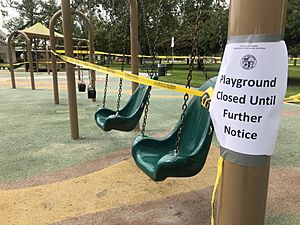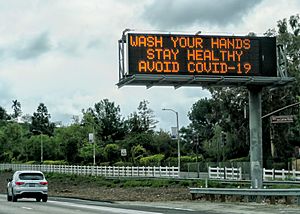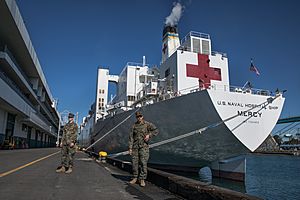Timeline of the COVID-19 pandemic in California facts for kids
A timeline helps us understand when important things happened during the COVID-19 pandemic in California. This timeline shares key moments and changes in California as the world faced the COVID-19 virus.
Contents
- COVID-19 in California: Key Events of 2020
- Early Days: January and February 2020
- March 2020: The Virus Spreads
- April and May 2020: Continued Rise
- June 2020: Mask Mandate and Disproportionate Impact
- July 2020: More Records and Hotspots
- August 2020: Cases Decline Briefly
- September 2020: Positivity Rate Drops
- October 2020: Cases Rise Again
- November 2020: Limited Stay At Home Order
- December 2020: New Records and Variant Detected
- COVID-19 in California: Key Events of 2021
- Images for kids
COVID-19 in California: Key Events of 2020
Early Days: January and February 2020
The first case of COVID-19 in California was confirmed on January 26. This was the third case in the whole United States. The person had traveled from Wuhan, China, and recovered at home. Soon after, more cases were found in Santa Clara County and San Benito County.
On January 29, the U.S. Department of State helped bring 195 Americans back from Hubei Province in China. They landed at March Air Reserve Base in Riverside County. More flights brought people to Travis Air Force Base and Marine Corps Air Station Miramar in early February, where they stayed for a 14-day quarantine.
A very important event happened on February 6. Patricia Dowd, a 57-year-old from San Jose, died. Later, in April, it was discovered she died from COVID-19. She had not traveled recently, which suggested the virus was already spreading in the community without anyone knowing, possibly since December.
Later in February, 338 Americans who were on the Diamond Princess cruise ship in Japan were brought back to California. Some of them were already infected with the virus.
On February 26, a case was found in Solano County where doctors didn't know how the person got sick. This was the first time a case appeared without a clear link to travel or another known infected person. This type of spread is called community transmission. Because of this, the CDC changed its rules for who could get tested for the virus.
March 2020: The Virus Spreads
March 1: Two healthcare workers in Alameda and Solano Counties got sick after caring for the patient from the February 26 case.
March 4: A person in Placer County who had been on the Grand Princess cruise ship died. This was the first COVID-19 death in California and outside of Washington state. California's Governor Gavin Newsom declared a State of Emergency. The Grand Princess cruise ship was ordered to stay offshore while people on board were tested for the virus.
March 5: San Francisco reported its first cases of community spread. Yolo County also reported its first case.
March 7: More cases were reported in Santa Clara County. A professor at Stanford University School of Medicine tested positive. Schools in Elk Grove closed after a family tested positive. Cases linked to the Grand Princess cruise ship were found in Santa Cruz, Madera, and Fresno Counties.
March 8: Contra Costa County and Santa Clara County reported more cases. Sierra College in Rocklin moved classes online. Shasta County reported its first case.
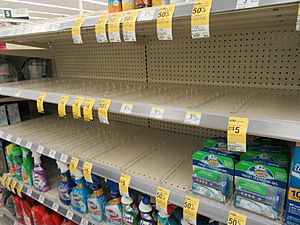
March 9: Sacramento County reported new cases. Santa Clara County announced California's second COVID-19 death, which was also a community spread case. An elementary school child in Elk Grove tested positive.
March 10: Governor Newsom announced 157 confirmed cases in the state. Alameda County and San Francisco reported new cases. San Francisco banned large gatherings. An older person in an assisted living home in Elk Grove died from the virus. Ventura County confirmed its first case.
March 11: Marin County reported new cases. A woman died in Los Angeles County, the fourth death in California. Three TSA agents at San Jose International Airport tested positive, leading to 42 agents being quarantined. A firefighter in Alameda also tested positive.
March 12: More cases were confirmed in Alameda County and San Francisco. Four firefighters with the San Jose Fire Department tested positive, and their family members also got sick.
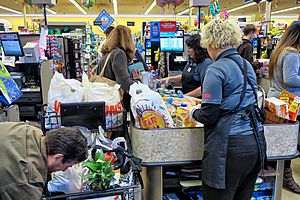
March 13: San Joaquin County reported more cases and declared a public health emergency, closing all schools. Santa Clara County reported more cases and its second death. More TSA agents and firefighters in San Jose tested positive. A Stanford University student also tested positive. Los Angeles County, San Diego County, and Contra Costa County reported increasing numbers of cases.
March 14: Santa Clara County and San Francisco reported more cases. San Francisco ordered hospitals to stop visitors. Marin County reported its first community spread cases. A U.C. Berkeley student tested positive. San Luis Obispo County and Sonoma County reported their first community spread cases.
March 15: San Francisco reported more cases, including two health workers at UC San Francisco. San Mateo County reported its first death. Santa Clara County reported more cases. Santa Barbara and San Bernardino Counties reported their first confirmed cases. Los Angeles County and San Diego County also saw their case numbers rise.
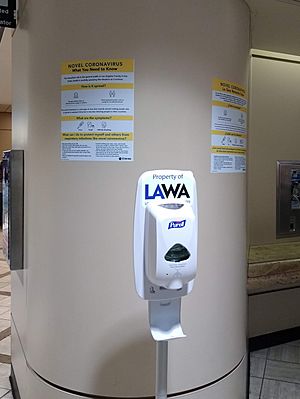
March 16: Many counties, including San Mateo, Alameda, Santa Clara, San Francisco, Los Angeles, San Diego, and Contra Costa, reported more cases. Nevada County reported its first case, linked to international travel.
March 17-25: During this period, the number of cases continued to rise rapidly across California. Major counties like Los Angeles, Santa Clara, San Mateo, San Francisco, and Orange County saw significant increases in confirmed cases and deaths. Many counties reported their first cases or first deaths. Health officials in Los Angeles County changed testing guidelines because they could no longer test everyone with symptoms.
A complex case involving a teenager in Lancaster was investigated. While initial tests showed positive for COVID-19, health officials later said they were looking into other possible reasons for the death.
March 26-31: Cases continued to climb sharply. Los Angeles County, Santa Clara, San Diego, Orange, San Francisco, and other counties reported hundreds of new cases daily. The USNS Mercy hospital ship arrived in Los Angeles to help local hospitals. The Los Angeles Convention Center was turned into a temporary hospital.
April and May 2020: Continued Rise
April 1: Santa Clara County reported over 950 cases and 32 deaths. They noted that limited testing meant the actual number of cases was likely much higher. Los Angeles County reported over 3,500 cases. Many other counties also saw significant increases in cases and deaths.
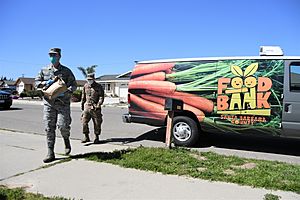
April 2-11: Case numbers continued to grow daily across the state, especially in Los Angeles, San Francisco, and Alameda Counties.
April 14: Los Angeles County recorded 40 deaths in a single day, a new record for the county. Over 10,000 COVID-19 cases were confirmed in Los Angeles County alone.
April 16: California recorded 101 deaths in one day, setting a new statewide record.
June 2020: Mask Mandate and Disproportionate Impact
June 4: Data showed that Latin-American people were affected more by COVID-19 in California. They made up 54% of cases but only 39% of the population. This was likely because many worked in essential jobs.
June 18: Governor Newsom ordered a statewide mask mandate. This meant people had to wear masks in most public places because cases and deaths were rising again.
June 21: The number of COVID-19 cases in California passed those in New Jersey.
June 24: California announced a record 7,194 new cases in one day.
June 27: A 19-year-old McDonald's worker in Oakland was hurt when she asked a customer to wear a mask.
July 2020: More Records and Hotspots
July 5: Actor Nick Cordero, a Los Angeles resident, died from COVID-19.
July 9: Governor Newsom reported a new record for COVID-19-related deaths.
July 15: Nearly 1,000 new cases were reported in child care facilities across California.
July 16: The city of Galt became a hotspot for the virus.
July 21: Orange County had the second-highest number of cases in California, just ahead of Riverside County. Los Angeles County had over 160,000 cases.
July 22: The entire state of California passed 409,000 COVID-19 cases, becoming the state with the most cases in the nation, surpassing New York.
July 26: A wedding in San Francisco was canceled after the newlywed couple and eight guests tested positive for COVID-19.
August 2020: Cases Decline Briefly
August 18: After a period of catching up on old case reports, California reported only 4,700 new cases in a single day. This was the lowest number since mid-June.
September 2020: Positivity Rate Drops
September 3: Hispanic and Latino Americans continued to make up a large portion of COVID-19 cases, around 60%. Filipino Americans were also heavily affected, partly because many work in healthcare.
September 8: The California Department of Public Health (CDPH) reported that the daily positive test rate was 4%, the lowest since May.
October 2020: Cases Rise Again
October 3: The CDPH reported over 810,000 confirmed COVID-19 cases and over 16,000 deaths in total. The average new daily cases were around 3,000.
October 25: The state passed 900,000 confirmed cases.
November 2020: Limited Stay At Home Order
November 19: The CDPH issued a "Limited Stay At Home Order" because cases were rising very quickly. This order required people in high-risk counties to stop gathering with other households and doing outside activities between 10:00 PM and 5:00 AM. It was in effect until January 25, 2021.
November 20: California had a week with three days where over 13,000 new cases were confirmed daily, a new record.
November 23: The Governor's family decided to self-quarantine after a security officer tested positive, even though the family tested negative.
December 2020: New Records and Variant Detected
December 8: California broke another single-day record with 34,490 new COVID-19 cases.
December 30: The first confirmed case of the SARS-CoV-2 Alpha variant was reported in California. This new version of the virus was found in Southern California.
COVID-19 in California: Key Events of 2021
January 2021: Alpha Variant Spreads
January 6: The CDC announced that at least 26 confirmed cases of the Alpha variant had been found in California.
January 11: California's death toll from the virus went over 30,000, just one month after it had passed 20,000 deaths.
February 2021: Death Toll Reaches 50,000
February 24: The state recorded 1,114 deaths in one day, a new record. This pushed the total death toll to 50,000. Many of these deaths were from Los Angeles County and had happened earlier but were just reported.
December 2021: Omicron Variant Detected
December 1: The first case of the SARS-CoV-2 Omicron variant in the United States was found in California.
Images for kids
-
Hand sanitizer sold out at a drug store in Folsom, California on March 9
-
Panic buying at a grocery store in Claremont, California on March 13
-
Hand sanitizer and COVID-19 information at Los Angeles International Airport on March 16, 2020
-
Empty shelves at a San Francisco grocery store after panic buying on March 17, 2020
-
The Los Angeles Convention Center turned into a field hospital on March 29 to treat COVID-19 patients
-
Members of the California National Guard delivering food to residences in Orcutt, California on April 2



